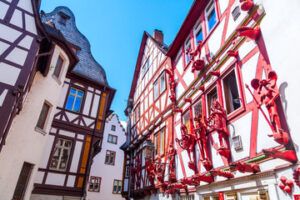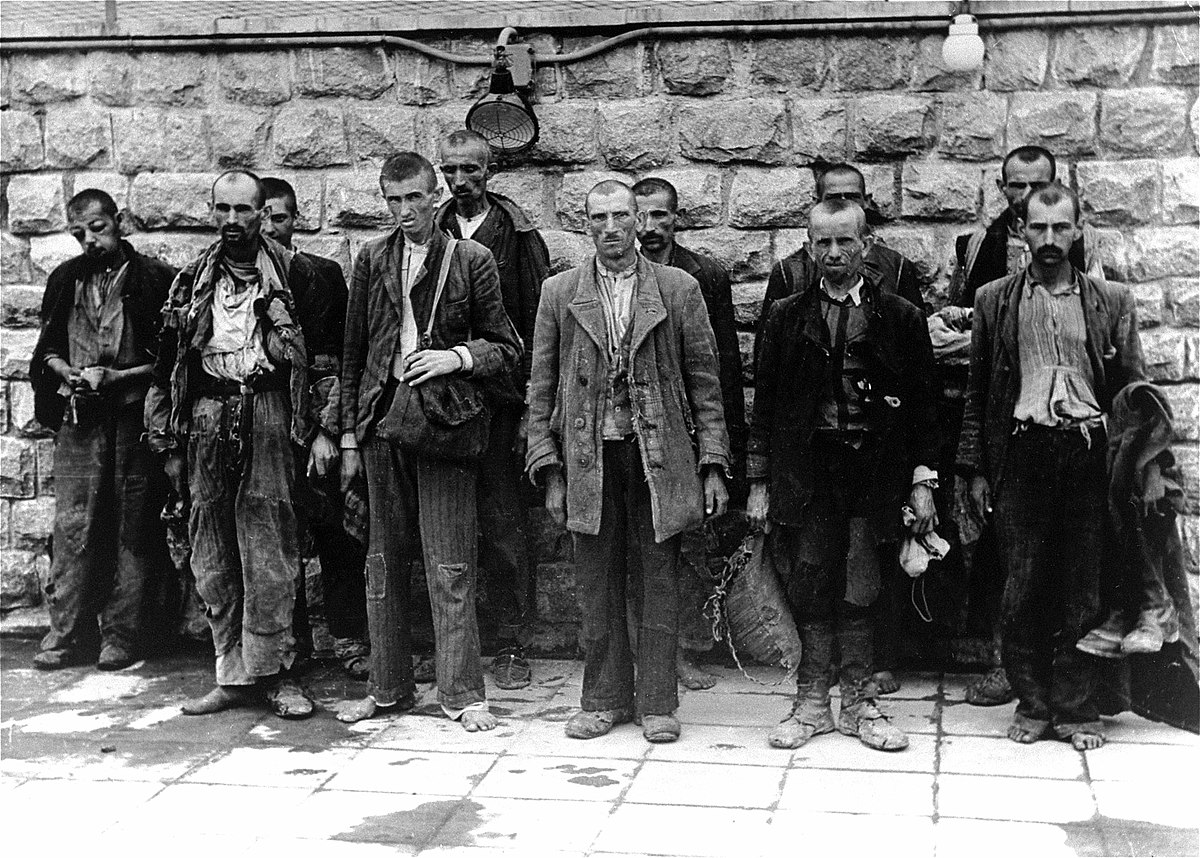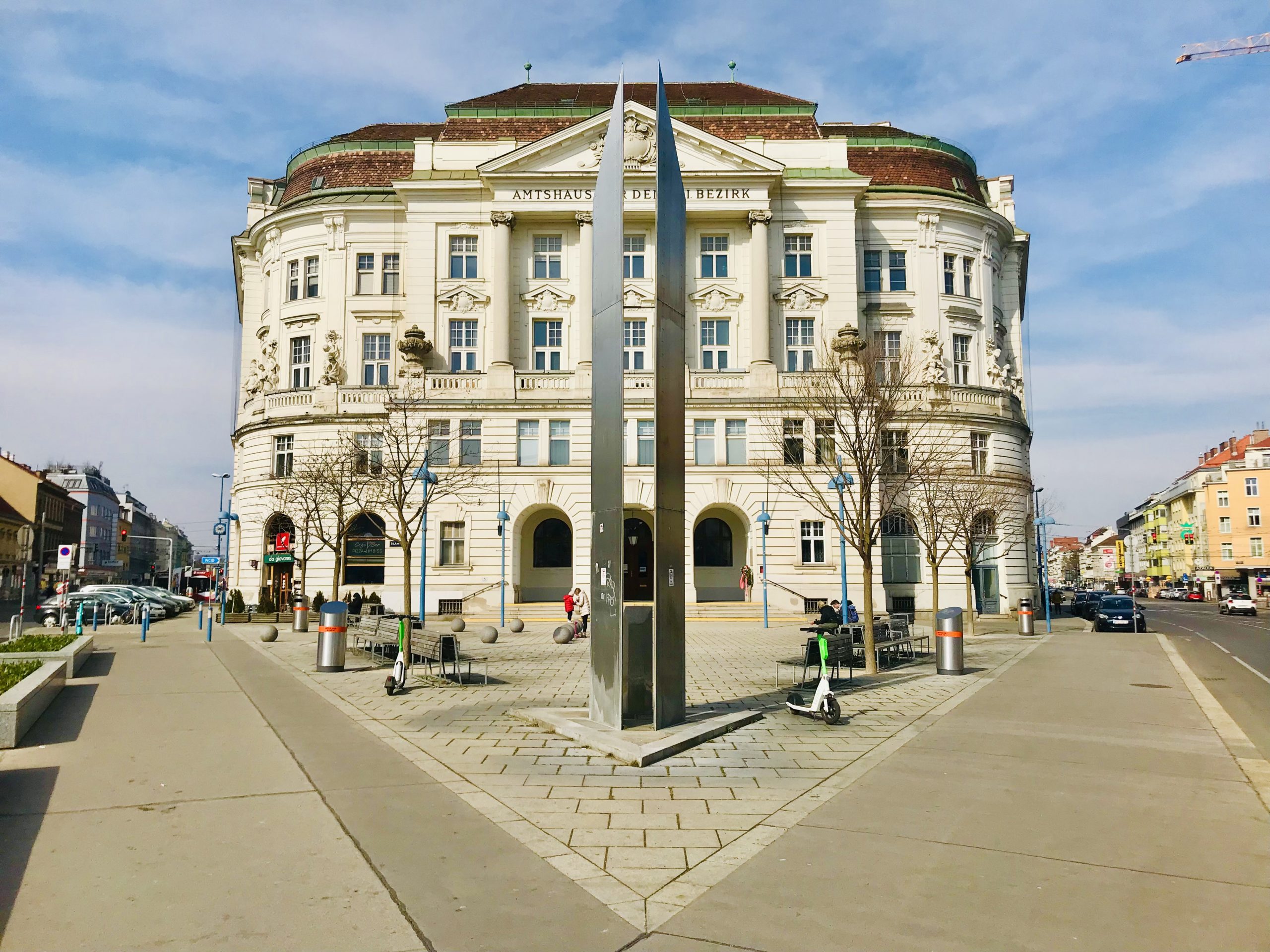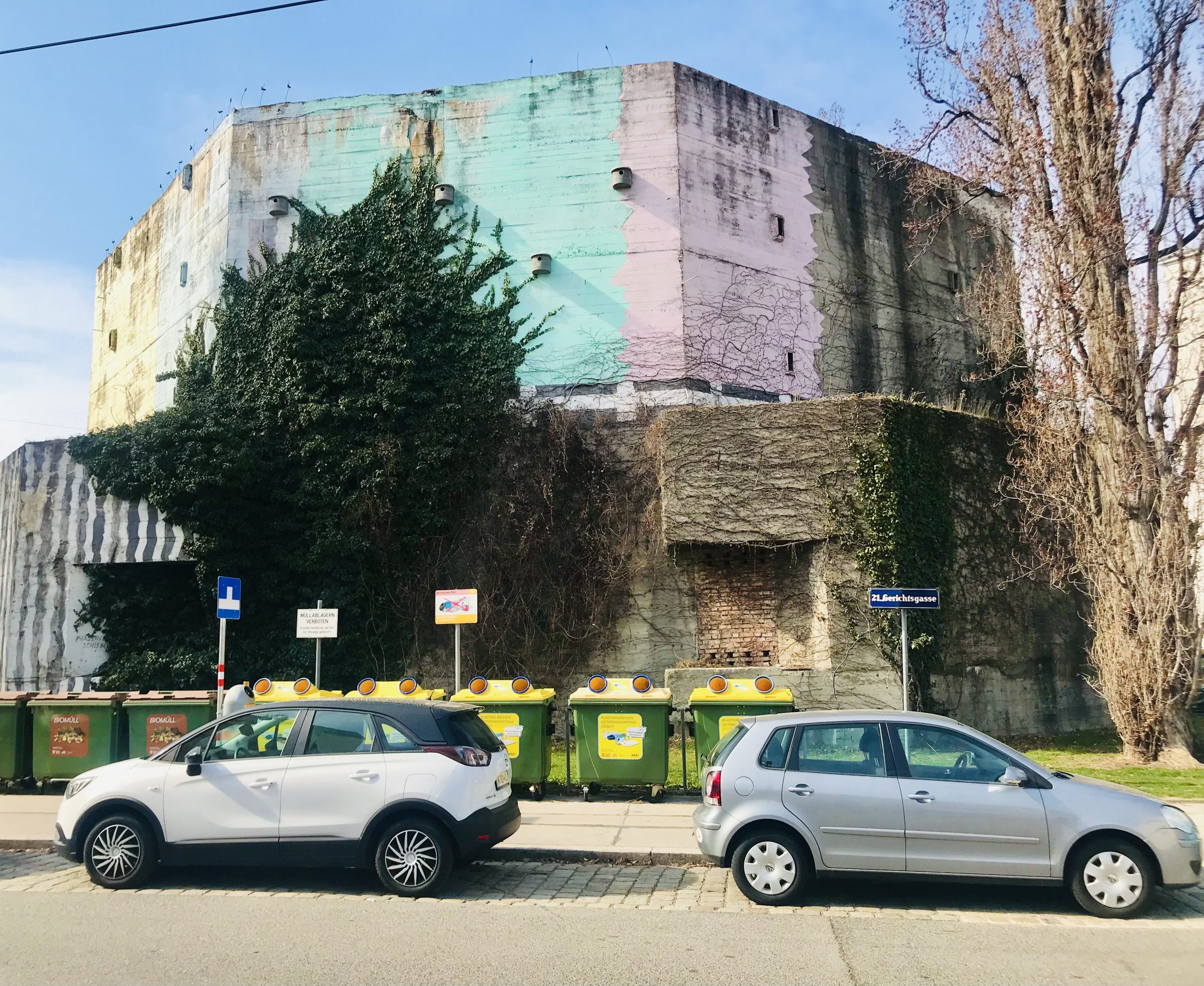UNTOUCHED BY TIME, LIMBURG AN DER LAHN HAS THE OLDEST HOUSE IN GERMANY AND THE HOUSE OF DEADLY SINS
Map Limburg an der Lahn, Germany
Table of Contents
- 1 UNTOUCHED BY TIME, LIMBURG AN DER LAHN HAS THE OLDEST HOUSE IN GERMANY AND THE HOUSE OF DEADLY SINS
- 2 WHAT MAKES LIMBURG AN DER LAHN SO AMAZING?
- 3 A BRIEF HISTORY
- 4 GUIDE TO THE BEST HALF-TIMBER FRAMED GINGERBREAD HOMES IN LIMBURG AN DER LAHN
- 5 GUIDE TO THE ALTSTADT (OLD TOWN) IN LIMBURG AN DER LAHN
- 6 OUR EXPERIENCE
- 7 PRO TIPS WHEN VISITING LIMBURG AN DER LAHN
- 8 RESOURCES
- 9 NEAR THIS PLACE
- 10 BEST PLACES TO STAY
- 11
Welcome to Limburg an der Lahn (Limburg for short) — the most amazing preserved medieval town you have never heard of. Located just a 45-minute drive from the modern financial powerhouse city of Frankfurt am Main, Limburg stands as one of the oldest towns in Germany. Despite its historical significance and charm, this gorgeous town remains largely undiscovered by most tourists.
You won’t find Limburg an der Lahn on any major tourist maps. But, it should be. As you will soon find, Limburg offers a plethora of things to see and do. This town deserves to be in every travel guide. So how can a preserved medieval town as interesting as Limburg an der Lahn have no fanfare whatsoever? Read on!
WHAT MAKES LIMBURG AN DER LAHN SO AMAZING?
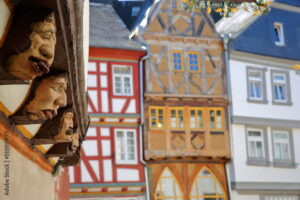 AdobeStock
AdobeStock
Limburg an der Lahn is defined by its unbelievable medieval half-timbered homes — the most preserved concentration anywhere in Germany. The gorgeous half-timber framed gingerbread homes that line the city streets were built between the 13th and 18th centuries. Their foundations have settled over time.
As a result, many of these magnificent homes lean over the cobblestone streets with their gables almost touching. They look like they could collapse without warning. Other homes are twisted and crooked, contorted by time. These imperfections add to the character of Limburg and are not to be missed.
The oldest free-standing house in Germany — Römer 2-4-6 — has called Limburg home for the past 731 years. If that wasn’t awesome enough, eight of the 20 oldest half-timbered homes in Germany can also be found in Limburg.
The House of Seven Deadly Sins is the city’s most well-known house and the most ornate. Limburg truly is a triumph of half-timber framed gingerbread houses. If you love gingerbread homes, then you have hit the motherlode!
A BRIEF HISTORY
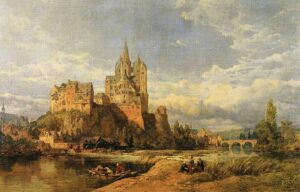 Wikimedia Commons
Wikimedia Commons
First mentioned in 910, the town of Limburg grew around the 9th-century Limburg Castle (Burg Limburg) on the Lahn River. Soon the St. George’s Monastery (later to become Limburg Cathedral) was erected and the town began to flourish both religiously and economically as Limburg increased in importance.
A GAME-CHANGING BRIDGE
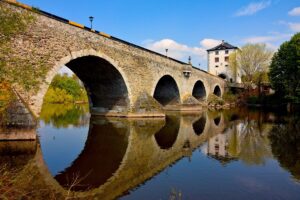 AdobeStock
AdobeStock
The year 1150 was a game-changer when engineers constructed a wooden bridge across the Lahn River. With this bridge, the long-distance trade route known as the Via Publica from Cologne to Frankfurt now ran directly through Limburg. Limburg quickly became a hub at the crossroads of commerce. Genius!
In 1306, the wooden bridge was replaced with a stone bridge — the Alte Lahnbrücke (Old Lahn Bridge) — after extensive flooding. At one time, the bridge was protected on both ends by towers. In addition to controlling access, the towers served as toll booths and were used to collect money from traveling merchants. This revenue directly funded the construction of the magnificent buildings in Limburg. The bridge tower gates were closed at night to prevent crossing during silent hours.
PROSPERITY
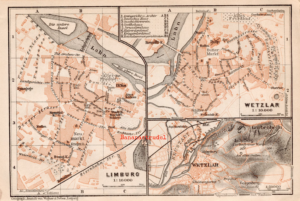 Wikimedia Commons
Wikimedia Commons
In the early 13th century, the Ysenburg family acquired the town and expanded Limburg Castle. The Ysenburgs would eventually own most of the land around modern-day Frankfurt. They would build a number of notable castles that still dot the countryside today. 1214 was a year to celebrate. Limburg officially became a town and was granted rights and a charter. The town blossomed and a 1000 meter (3280 feet) long wall was built around Limburg.
The ruling class of wealthy merchants started a construction boom. They erected their homes next to the castle and within the safe confines of the town wall. Similar to most medieval towns, the ruling class called all the shots. They made the rules and spent the town’s money. Until 1458, the working class had no representation on the town council and no voice in the town’s affairs. Yet, they paid the majority of the taxes that kept the town afloat.
WHO WERE THE SÄCKERS?
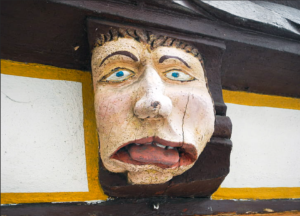 AdobeStock
AdobeStock
Limburgers are locally known as Säckers. According to legend, the name originated during the Middle Ages when two overstuffed wagons got stuck in the narrow alleys of Limburg. It seems the wagons had to be unloaded by “sackers.” This seems to be total fiction. A more realistic explanation from the 19th century is that goods placed in sacks were traded up and down the Lahn River. These were unloaded by day laborers in Limburg and brought to the warehouses on Philippsdamm.
The laborers were popularly known as sackers. At the end of the day, the sackers received their wages. They generally went straight from work to the local tavern to purchase brandy. The room in the tavern where the children were playing had to be cleared quickly. The Haus Frau would shout, “Children, make room, the sackers are coming!” Today, Limburg’s oldest residents are known as “noble sacks.”
MISFORTUNE
In 1337, the Limburg town council expelled all of the town’s Jews. Four years later by royal decree, the Jewish families were allowed to return to Limburg. Sadly, Limburg faced a streak of misfortune when the town caught fire in 1342 and the Black Death took its toll in 1349, 1356, and 1365. Regional rivalries and family power struggles would chip away at the town’s stability. In 1525, the German Peasant’ War would result in further unrest. The Holy Roman Emperor Charles V quickly put down this uprising against the aristocracy. His troops slaughtered up to 100,000 poorly armed peasants and farmers in the process. Yikes.
WW2
Things remained relatively quiet in Limburg for centuries. Then, during WW1, Limburg became the site of a major prisoner of war camp for British and Irish soldiers. From 1919 to 1923, Limburg was the capital city of a short-lived state called the “Free State Bottleneck.”
In 1933, National Socialists pushed their way into power in Limburg. The Nazis forced Limburg’s Jews to emigrate and confiscated their property and businesses. In 1938, the SS burned down Limburg’s synagogue. During the Holocaust, 189 Jews from Limburg were killed by the Nazis. Today 108 Stones of Remembrance have placed in front of homes occupied by Jewish residents to honor their memory.
GUIDE TO THE BEST HALF-TIMBER FRAMED GINGERBREAD HOMES IN LIMBURG AN DER LAHN
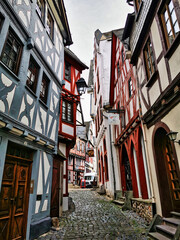 AdobeStock
AdobeStock
Limburg has been designated a must-see site on the German Timber-Frame Road, which runs almost the length of Germany from the Elbe River to Lake Constance. Checking out Römer 2-4-6 and the House of Seven Deadly Sins should be among the top things you do in Limburg an der Lahn. We have provided a list below of the best half-timbered homes in the city. Although we have provided the addresses in Google Maps, part of the fun is finding these amazing structures.
LIMBURG STREET MAP WITH IMAGES. Click here for a detailed street map that has images and history for every house in Limburg an der Lahn.
GERMAN TIMBER-FRAME HOUSE ROAD MAP. Click here to learn more about the German Timber-Frame House Road Map.
Römer 2-4-6
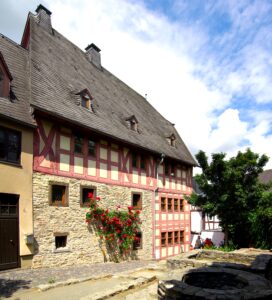 wikimedia commons
wikimedia commons
The crown jewel of Limburg an der Lahn is the Römer 2-4-6, the oldest free-standing unaltered building in Germany. This remarkable Gothic timbered house was built in 1289 and little has changed in 731 years other than the occupants of this architectural gem.
The house was originally built as a merchant’s house, and it has had a variety of uses over the centuries. It has been a tavern, a bakery, and a private residence. In the 19th century, it was owned by a Jewish family, and a mikvah (Jewish ritual bath) was discovered in the garden in the 20th century.
Römer 2-4-6 is a significant historical building for a number of reasons. It is one of the oldest timbered houses in Germany, and it has survived centuries of wars, fires, and other disasters. It is also a valuable example of medieval architecture and craftsmanship.
The house is also important for its Jewish history. The mikvah that was discovered in the garden is one of the few remaining mikvahs in Germany, and it is a reminder of the Jewish community that once lived in Limburg.
Römer 2-4-6 has a unique and important place in Germany’s history. If you don’t do anything else in Limburg, seeing this structure is the one thing you absolutely need to do. ADDRESS: Römer 2-4-6, Limburg an der Lahn.
![]()
House of the Seven Deadly Sins
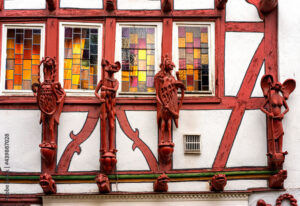 AdobeStock
AdobeStock
Built in 1567, the House of the Seven Deadly Sins (Haus der Sieben Laster) in Limburg, Germany is one of the most popular half-timbered houses in Limburg. The facade of the house is decorated with seven grotesque faces carved into the beams, representing the seven deadly sins in Christianity: pride, envy, greed, lust, gluttony, wrath, and sloth.
The exact purpose of the carvings is unknown. One theory is that the carvings were meant to be a warning to passersby about the dangers of sin. Another theory is that the carvings were simply meant to be decorative or to add a touch of flair to the house. Whatever the reason for the carvings, the House of the Seven Deadly Sins is a unique and fascinating building that has been featured in numerous books, articles, and films.
The house was originally built as a private residence, but it has been used for a variety of purposes over the centuries. At one time, it was a hostel, and later it was a bakery. Today, the house is home to an art gallery and an antique shop.
The House of the Seven Deadly Sins is a reminder of the rich history and culture of Limburg. It is a must see for any tourist visiting the city. ADDRESS: Brückengasse 9, Limburg an der Lahn.
![]()
Haus Kleine Rütsche 4
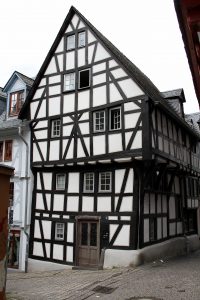 wikimedia commons
wikimedia commons
Built in 1289, this house is located at the narrowest spot on the historic trade road between Frankfurt and Cologne. With the understanding they would be passing through Limburg, carriages were loaded beforehand so they could fit through the narrow alley. To prevent traffic jams in Limburg, customs officials inspected the carriages several blocks away in either direction. To this day, the Heumarkt or Haymarket in Cologne has depictions of the steps that must be taken prior to traveling to Limburg. ADDRESS: Rütsche 4, Limburg an der Lahn.
![]()
Werner-Senger Haus
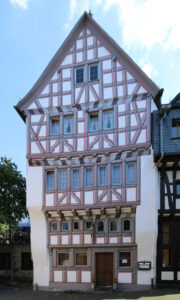 Wikimedia Commons
Wikimedia Commons
A beautiful stone hall house built in 1289 by wealthy Limburg merchants. Today, this magnificent building is the location of the Werner-Senger House restaurant, one of the oldest continuously operated restaurants in Germany. In 1802, robber Johannes Bückler (known as Schinderhannes), was arrested near Limburg and was detained in this house. The Werner-Sanger Haus is one of the oldest homes in Limburg’s old town. ADDRESS: Rütsche 5, Limburg an der Lahn.
![]()
Fischmarkt
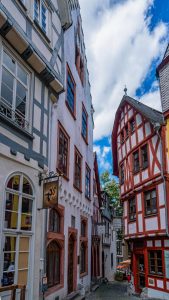 limburg.de
limburg.de
Since the 13th century, this popular market square housed Limburg’s wool weavers before becoming the location of the town’s fish market. It is located on the banks of the Lahn River, and it is surrounded by half-timbered houses dating back to the 16th and 17th centuries.
The Fish Market has been used as a market square for centuries. In the Middle Ages, fish was brought to the market from all over the region, and it was sold to the people of Limburg and to travelers passing through the town.
The Fish Market was also a place where people gathered to socialize and to exchange news. It was a lively and bustling place, and it played an important role in the life of the community. In the 19th century, the Fish Market declined in importance as other markets in Limburg were developed. However, it still remained a popular place for people to gather.
Today, the Fish Market is a popular tourist destination. It is also a popular place for locals to gather and to enjoy a meal or a drink at one of the many outdoor cafes and restaurants. ADDRESS: The Steinernes House built in 1350 is located at Fischmarkt 1. Other gorgeous half-timber homes are Fischmarkt 9, 12, and 16/17, Limburg an der Lahn.
![]()
Bischofsplatz 5-9
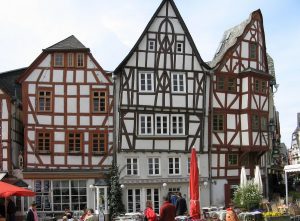 wikimedia commons
wikimedia commons
These gorgeous half-timber houses adorn Bischofsplatz (Bishop’s Square), the central square in Limburg an der Lahn. The square was probably created in 1322 with the construction of the present-day city church (formerly the Barfüßerkirche), which was built for the Franciscan monastery that had existed there since 1232. The monastery’s former 18th-century buildings (later the bishop’s palace, now the bishop’s ordinary) and the church now border the square to the east.
In the Middle Ages, Bischhofsplatz was one of the most important squares in Limburg. The Franciscan monastery was a major religious and cultural center, and the square was also a popular place for markets and festivals.
Until the 19th century, there was a walled cemetery in front of the Franciscan church, and the first Limburg grammar school was located in front of the monastery building from 1636. To the south is Frankfurter Straße, which led to the Hammerpforte, in front of which the Frankfurt suburb (Hammervorstadt) developed from the 14th century. The well-known city clerk Tilemann Elhen von Wolfhagen lived in the corner house Frankfurter Straße 1 at least from 1392; the ground floor was used as a bakery from the 17th to the second half of the 20th century.
Today, Bischhofsplatz is home to several historical buildings and is a popular tourist destination. It is also a popular place for locals to gather and to enjoy a meal or a drink at one of the many outdoor cafes and restaurants. ADDRESS: Bischofsplatz, Limburg an der Lahn.
![]()
Staffel Haus (Bishop’s Residence)
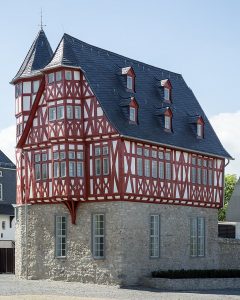 wikimedia commons
wikimedia commons
The Staffel House (also known as the Old Vicariate or formerly the Cathedral Coaster House) is a listed half-timbered house on the Cathedral Square. It is considered the most important late medieval residential building in the city. The Staffel Haus underwent extensive renovations in 2012-2103. Today, it is the residence of the Limburg bishop. ADDRESS: Domplatz 7, Limburg an der Lahn.
![]()
Zum Goldenen Hirsch
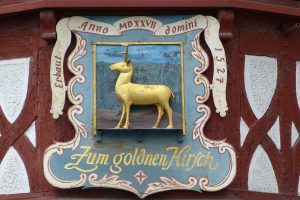 wikimedia commons
wikimedia commons
Since 1527, the Zum Goldenen Hirsch (to the Golden Deer) operated as an inn on the Kornmarkt. Although it ceased being an inn in the early 20th century, its magnificent preserved medieval sign still adorns the building. ADDRESS: Kornmarkt 3, Limburg an der Lahn.
![]()
Haus Trombetta
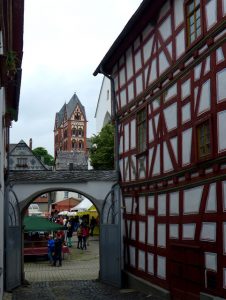 wikimedia commons
wikimedia commons
Built in the 16th century, Haus Trombetta is one of the oldest half-timbered houses in the city. The house is named after the Trombetta family, who were prominent merchants and landowners in Limburg. The family owned the house for over 200 years.
In the 19th century, the house was used as a hotel. In the 20th century, it was used as a residential building. Today, the house is home to a restaurant and a bar. It is also a popular tourist destination, due to its well-preserved half-timbered facade. ADDRESS: Frankfurter Straße 2, Limburg an der Lahn.
![]()
Haus Plötze 17
 wikimedia commons
wikimedia commons
Haus Plotze (also known as Haus Plotzer Hof) is a historic half-timbered house in Limburg, Germany. It is located at Frankfurter Straße 18 and is one of the oldest houses in the city, dating back to the 15th century.
The house is named after the Plotze family, who were prominent merchants and landowners in Limburg. The family owned the house for over 300 years. In the 17th century, the house was used as a tavern. In the 18th century, it was used as a private residence. In the 19th century, it was used as a hotel.
Here are some additional facts about Haus Plotze:
- The house is four stories high and has a gable roof.
- The facade is decorated with intricate carvings, including the Plotze family crest.
- The house has a number of original features, including a wooden staircase and a beamed ceiling.
- The house was renovated in the 20th century, but its original character was preserved.
- Haus Plotze is a listed building, meaning that it is protected from demolition or alteration.
Today, the house is home to a restaurant and a bar. It is also a popular tourist destination, due to its well-preserved half-timbered facade. ADDRESS: Haus Plötze 17, Limburg an der Lahn.
GUIDE TO THE ALTSTADT (OLD TOWN) IN LIMBURG AN DER LAHN
Limburg’s Altstadt or Old Town is remarkable in that it is chock-full of preserved medieval buildings. Once surrounded by a city wall, the Old Town occupies the area between Limburg Cathedral (St. George’s Cathedral), Grabenstraße, and the 600-year-old Lahn Bridge. Grabenstraße marks the area where the Old Town moat once existed. This area is defined by narrow cobblestone streets with half-timber framed gingerbread homes.
Limburg Cathedral (St. George’s Cathedral)
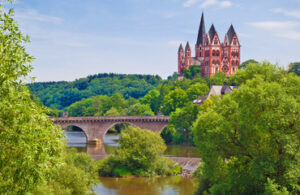 AdobeStock
AdobeStock
The Limburg Cathedral is identifiable by its red exterior and is located high on a rock overlooking the town. Construction on the cathedral began in 910. Known for its semi-circular arches, the cathedral is considered one of the most notable examples of late Romanesque architecture. It is covered with frescoes that date back to the 1200s. The cathedral’s peal consists of nine bells. Seven bells form the main peal and are located in the south tower. The largest and smallest of these bells were saved from destruction during WW2. The two bells hanging in the north tower date from the early 13th century. From 1960 to 1989, an image of the cathedral appeared on the 1,000 Deutsche Mark note. ADDRESS: Domstraße 12, 65549 Limburg an der Lahn.
![]()
Cathedral Treasury (Diocesan Museum)
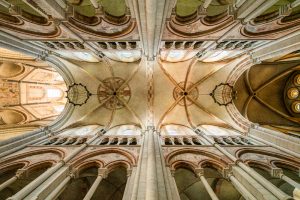 cwshier.com
cwshier.com
The treasury contains some rather interesting relics. Among them is a 10th-century Byzantine chest containing what is professed to be a piece of wood from Christ’s cross. This chest was stolen from Constantinople in 1204 and resurfaced in Limburg in 1827. The second chest is from the year 988 and contains what is claimed to be a portion of St. Peter’s staff. The treasury is housed what was once the Burgmannenhaus. The Burgmann was a knight who was responsible for defending the town and the aristocracy from invasion. Built in 1544, the Burgmannenhaus was occupied by the knight and other defenders of the town. Today, this location is the Diocesan Museum. ADDRESS: Domstraße 12, 65549 Limburg an der Lahn.
![]()
Limburg Castle
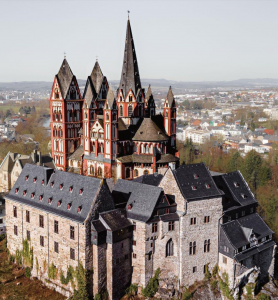 google maps 2022
google maps 2022
Constructed in the 800s and located at the rear of the cathedral, the Ysenburg family expanded the castle in the early 13th century. In 1995 the state of Hesse wanted to sell the castle to a private investor. After considerable public backlash, the city of Limburg bought the system for the symbolic price of one mark in 2000. ADDRESS: Mühlberg 2, 65549 Limburg an der Lahn.
![]()
Rathaus (Town Hall)
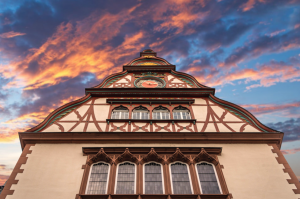 limburg-und.du.de
limburg-und.du.de
Although a very ornate half-timber framed structure, the Town Hall was built in 1899. ADDRESS: Werner-Senger-Straße 10, 65549 Limburg an der Lahn.
OUR EXPERIENCE
I needed to collect my wife at the airport in Frankfurt and had some time to spare so decided to explore this little town that had piqued my interest. After some research on things to see and do outside of Frankfurt, I was excited by the words “oldest standing house in Germany” and “‘half-timber” and decided to spend my afternoon in Limburg an der Lahn.
A quick 45-minute drive from Frankfurt, Limburg is very unassuming from the highway. You would never even know that this medieval gem exists. We found parking ample parking in an underground garage next to the Woolworth department store. Emerging one block over from the modern parking garage, we had time-warped and were now in the middle of medieval Germany. We spent the next several hours exploring the town on foot investigating each of the tiny alleys.
We marveled at the awesome half-timber framed houses with their gables nearly touching over the streets. The houses, ancient and proud, were amazing in their imperfection. It is hard to believe that Limburg has remained such an unspoiled hidden gem. For such an amazing place, there is hardly any information to be found in German and even less in English. The best part of Limburg is really Limburg itself. Have a coffee and dessert, some lunch, or a beer in one of the medieval houses. Pack a lunch. Let your curiosity lead you. Soak it all in. There are a number of amazing things to see and do in Limburg an der Lahn. It truly is the most incredible medieval town you have never heard of.
PRO TIPS WHEN VISITING LIMBURG AN DER LAHN
PRO TIP 1. There are three underground parking garages surrounding the Woolworth store with ample parking. They are centrally located and easy to find. ADDRESS: Grabenstraße 24 a, 65549 Limburg an der Lahn.
PRO TIP 2. Navigating Limburg an der Lahn is easy. Although there are some inclines, all of the roads are relatively paved or are laden with cobblestone. There is a lot to see in a concentrated area.
PRO TIP 3. Located in a house dating to 1364, Cafe Will has been a family run cafe and bakery since 1880. In 1959, Heinz Will invented the “Aero Cream Flash,” a mechanical cream blower with an electric motor. Today, Alexander Will and his girlfriend Theresa continue to run the café. Alexander is a professional baker and a German design award winner. ADDRESS: Salzgasse 23, 65549 Limburg an der Lahn.
cafe-will.de
RESOURCES
TOURISM OFFICE. Barfusserstrasse 6, 65549 Limburg an Der Lahn; Tel: (0049) 6431.6166; Email: [email protected]
NEAR THIS PLACE
TRAVEL GUIDE | ROTHENBURG OB DER TAUBER. Rothenburg ob der Tauber, a fairytale Bohemian town of gingerbread buildings surrounded by an impressive medieval wall located along Germany’s Romantic Road.
TRAVEL GUIDE | BAMBERG. A UNESCO World Heritage Site, Bamberg is a medieval jewel with an impressive Altes Rathaus (Old Town Hall), and a network of bridges and Old Town.
TRAVEL GUIDE | REGENSBURG. A UNESCO World Heritage Site, Regensburg has the largest preserved medieval old town north of the Alps. Regensburg also has several fine Roman exhibits.
TRAVEL GUIDE | NAZI PARTY RALLY GROUNDS. The Nazi Party Rally Grounds in Nuremberg, a deserted Zeppelin airfield, the unfinished Congress Hall, and other structures that once hosted one of history’s most evil man and his devoted followers.
TRAVEL GUIDE | NUREMBERG PALACE OF JUSTICE. Evil was on trial in courtroom 600 of the Nuremberg Palace of Justice.
TRAVEL GUIDE | SCHWÄBISCH HALL. A medieval time-capsule of lanes, soaring massive half-timbered houses, and covered bridges that are straight out of a Brothers Grimm fairy-tale.
BEST PLACES TO STAY
KONRADS GASTHAUS. This bed and breakfast is centrally located with river views, a terrace, and FREE Wifi. A continental breakfast is available each morning at the bed and breakfast. ADDRESS: Konrad-Kurzbold-Straße 4, 65549 Limburg an der Lahn, Germany.
VIENNA HOUSE EASY LIMBURG. Centrally located minutes from the Old Town. Modern and spacious rooms with FREE Wifi. Guests also enjoy FREE digital newspapers and a complimentary bottle of water. A breakfast buffet is available each morning in the breakfast room or on the garden terrace. ADDRESS: Schiede 10, 65549 Limburg an der Lahn, Germany.
HOTEL AMTS-APOTHEKE. Stylish rooms with FREE Wifi only minutes from the Limburg train station. All rooms feature a private bathroom with rain shower, some rooms include a Nintendo Wii. ADDRESS: Grabenstraße 32-34, 65549 Limburg an der Lahn, Germany.
TAFELSPITZ. Bright rooms with a terrace centrally located in the Old Town. A sauna and fitness studio are located next door. ADDRESS: Grabenstrasse 16-18, 65549 Limburg an der Lahn, Germany.
![]()



